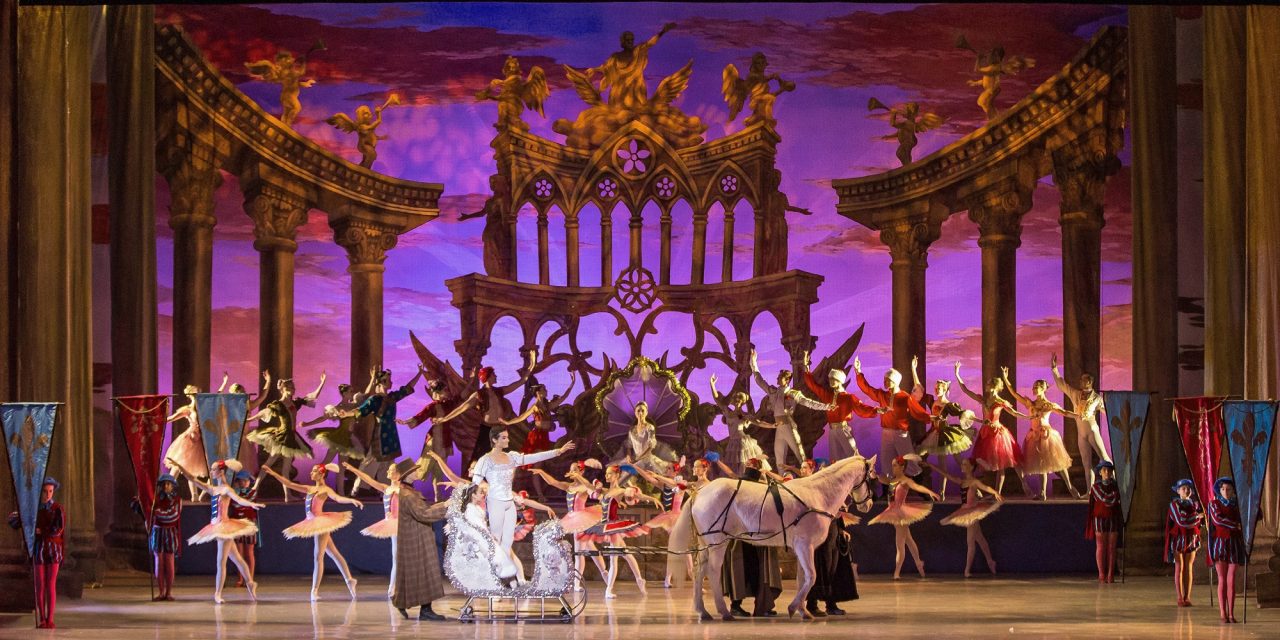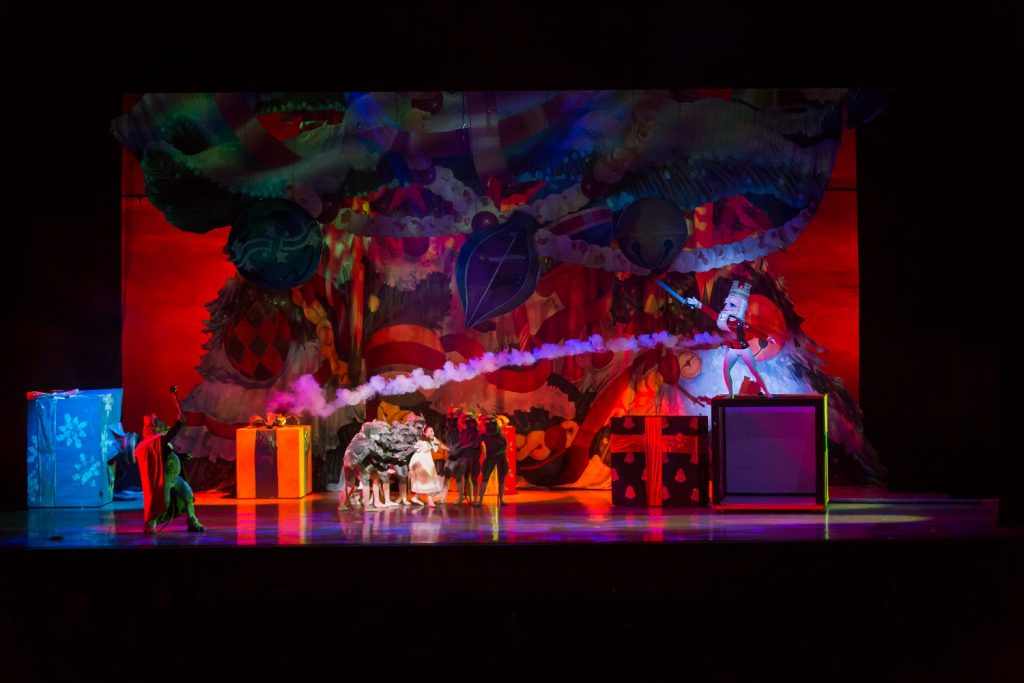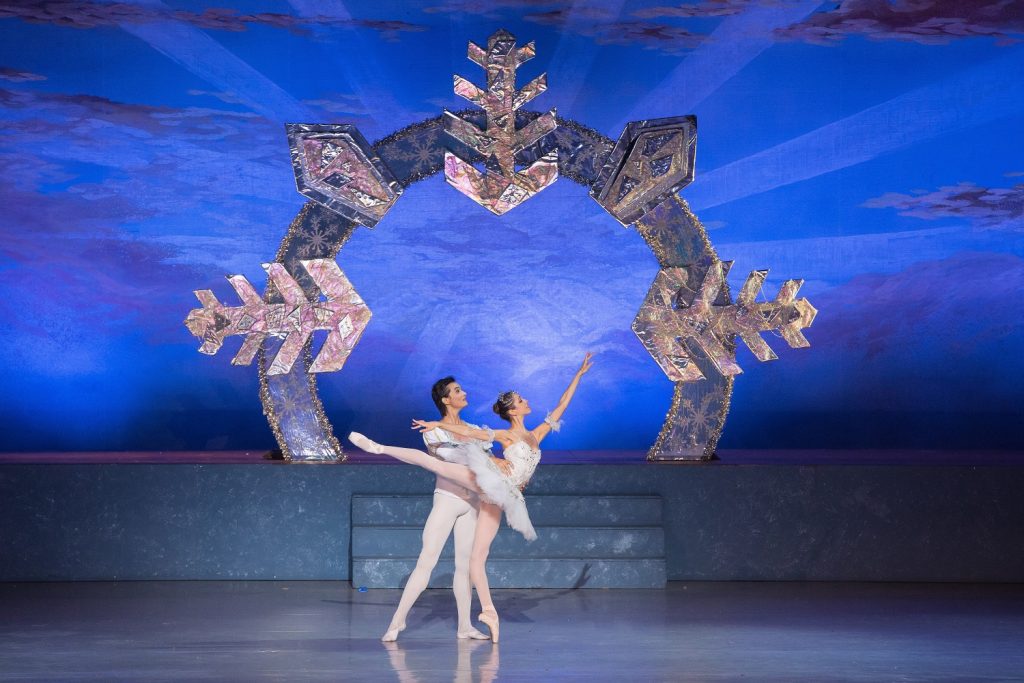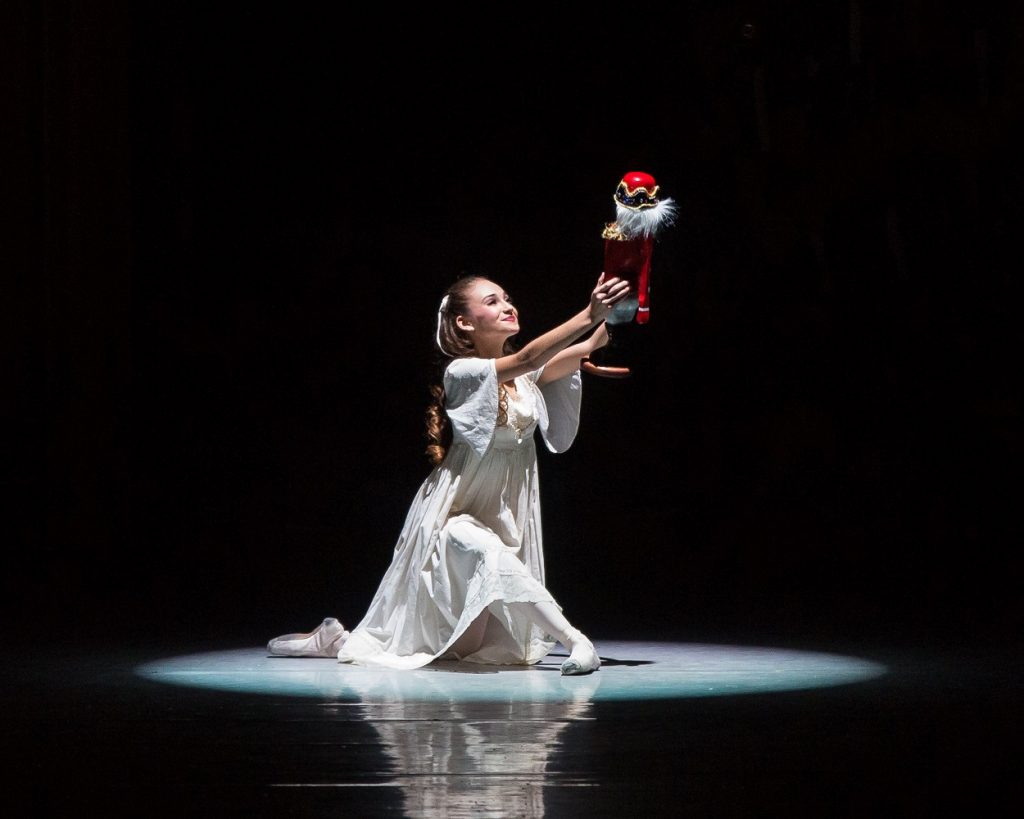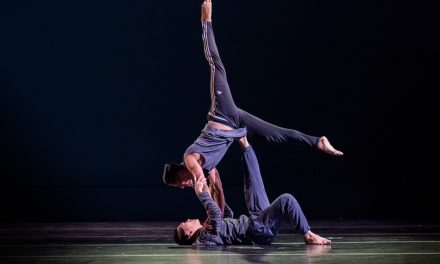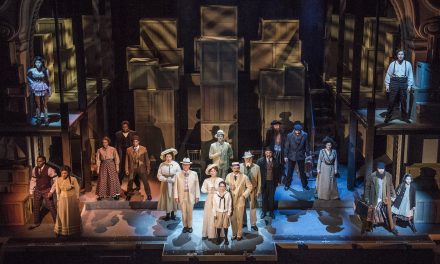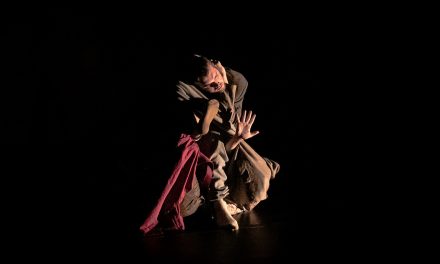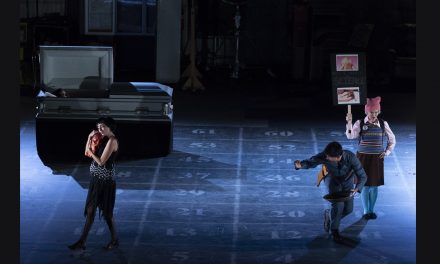Last, but not last, is the third installment of my LA Nutcracker Series: Long Beach Ballet’s larger than life production at the Long Beach Terrace Theater. 2018 was the ballet’s 36th Nutcracker. Since it has become the only piece the ballet performs annually, the academy pours everything they’ve got into sets, design and pyrotechnics to create a fun-loving show that leaves audiences “oohing” and “aahing” at every turn. Their interpretation of E.T.A. Hoffmann’s original story occasionally feels more dated than traditional but does not fail to entertain through and through. One major drawback in this year’s performance was a few very unsteady dancers that put a damper on some of the ballet’s scenes. However, the leads were spectacular and, coupled with the presentation, created a generally harmonious production.
As most companies do, Long Beach Ballet immediately put their signature on The Nutcracker with their opening scene. Before the Christmas Eve festivities put the plot in motion, heroine Clara Staulbaum (Vera Fratovich) had a very sweet exchange with a sad chimney sweep (Ken Datugan) to whom she gave a Christmas present after he was rejected from her family’s fancy party. Though not entirely necessary to the storyline, choreographer and artistic director David Wilcox (additional choreography by Terri Lewis) used this segment to establish a clear image of Clara as a young and innocent character. As the production progressed, there were continuous hints suggesting she was meant to be seen exclusively as a child, starting with her presence at the party, which did not set her apart from the rest of the young guests. This choice slightly took away from the story’s depth as she remained stagnant throughout the course of the show. What wasn’t static however was the children’s dancing, primarily that of Fritz (Alfredo Garcia) and Fratovich, who was wonderfully delicate. Her execution was both gentle and very in tune with the traditional aesthetic Long Beach showcased through their heavy inclusion of pantomime in between dancing.
Aside from the movement, Long Beach’s classic approach was evident in the set, which was by far, the most elaborate and beautiful background I have personally seen in any Nutcracker. Designed by Elliott Hessayon, Rex Heuschkel and Scott Shaffer, multiple backdrops created a layered effect, which added a lot of depth to the background, truly making it appear as though the first scenes of the story took place in a giant parlor with high ceilings. Painted portraits of Dr. and Mrs. Staulbaum (Mariano Sanz and Arlene Dragon)’s “family members” decorated the tall walls, while a two-dimensional Christmas tree added a simple, finishing touch to the look. Coupled with bright and well-timed spotlights (lighting design by Jared Sayeg), the show was undoubtedly visually captivating.
Drosselmeyer (Ben Majors) seemed as though he may have been an extension of the props and scenery. Adrian Clarke, Donna Dickens, Ann de Farra, Hilde Byrne and Cheryl Cartwright’s candy-colored costume design was equally marvelous to look at throughout the entire show, except when it came to Clara and Fritz’s odd uncle. His overall appearance clashed with his mysterious actions, especially his oversized walrus mustache, which made him look like a clown or cartoon. Majors’ presentation of the character was equally silly, with his head shaking and wide-eyed expressions. The result may have been cute for the kids in the audience who surely appreciated a less serious Drosselmeyer, but his eccentricities didn’t quite match up to the character’s power, considering the fact that he is the key-holder to the ballet’s story after gifting Clara her nutcracker doll.
One of the things Drosselmeyer does add to the ballet however is an introduction to the world dancing, thanks to his presentation of a few life-sized dolls. An appetizer for what’s to come, the dolls foreshadowed the theme that would take place later in the ballet—like Los Angeles Ballet, Long Beach had swapped their desserts for a worldwide display of dancers from around the world. A riff on the same traditional dances, but without the old 19th century trading and food associations, this act of modernization, along with LBB’s use of technology in later scenes, added a fine balance to the company’s otherwise old school production.
Adorably portrayed as a puppet show come to life, the three dancers featured in this scene were the Harlequin and Columbine Dolls (Saxon Wood and Satya Miller) from Italy and a Moor Doll (Christopher McDaniel) from Africa—an active and positive attempt to include all parts of the world in the ballet. Wood and Miller had a very skippy and cute routine, which paired them together exquisitely—a task that seems to be overwhelmingly successful in all the Nutcrackers I’ve seen this season. McDaniel’s routine however included a few fuzzy moments with a slight lack of clarity in many of his movements—an unfortunate foreshadowing of some of the other blunders I saw during my December 23 viewing of the show.
After an evening full of merriment and some light-hearted tomfoolery, the climactic fight between the Nutcracker Doll (Brent Shavelle) and the Mouse King was plenty of fun. LBB staged it in the Staulbaum living room. Once everyone has gone to bed, Clara who climbed downstairs hoping to be near the nutcracker doll left under the tree. The stroke of midnight was illustrated cleverly with a projection (technical direction by Mike Costa) of the all-knowing Drosselmeyer on the face of the clock as a warning of what was to come.
Once they appeared, the horde of mice quickly pounced upon Clara and steal the doll from her, causing the shy girl to become overwhelmed and faint upon her uncle’s arrival to help tame the chaos. Fratovich’s brief, but elegant duet with Majors was a curious juxtaposition to that of the mice’s prancing and pitter-pattering. The rodents’ role, which was key to the scene, seemed diminished by comparison as they trembled in fear of the tricky clock–and-toymaker before his disappearance. The same could be said of the more daring Mouse King (Craig Rexroad), who also relied more on stance than movement.
The transformation of the nutcracker into a life-sized doll was done with a powerful pyrotechnic flash that pleasantly shocked the audience and began the well-staged battle between the two sides. Behind him, the tree, which was revealed to be a tapestry began to stretch upward, growing until the painted ornaments appeared bigger than the doll’s giant head. Enlarged gifts appeared on either side of the doll, suggesting that the group might have shrunk instead. From within one of the gifts appeared a canon that added to the firework splendor with bright sparks flying everywhere.
The nutcracker’s death, paired with Long Beach Ballet Orchestra’s performance of Tchaikovsky’s soft and slow soundtrack, provided a fantastic build-up to the reveal of the Nutcracker Prince (Seth Orza, appearing courtesy of the Pacific Northwest Ballet) who rose from behind the doll’s silhouette like a phoenix springing from the ashes. His pas de deux with Clara was sweet and emphasized a platonic love. Orza was swift and well-balanced as the Prince—a shining white knight who shed some light upon Clara after her scary adventure with the rats.
Their venture into the Land of Snow was quick and seamless, requiring no carriage as the tapestry tree rose revealing a snowflake arch, wispy blue background, and the Snow King (Evan Swenson) and Queen (Hailey Pemberton) who took a running head start onto the stage before the tree had fully disappeared. Pretty poses and breathtaking lifts made the pair a strong couple and provided a welcome transition into the beautiful side of the ballet. The two glided together all along the stage before resting at the top and inviting the Snowflakes to appear—14 girls and women who scampered onto the stage as soon as a translucent scrim with black winter trees on it veiled the royal couple from view. Splitting up into groups of three wherein they performed pirouettes and quick turns, their vivacity was a picturesque representation of a light blizzard. The spunk in their step was matched by a peppier reappearance of the Snow Royalty. The scrim was raised, and Clara and the Nutcracker Prince stepped into a Pegasus-drawn carriage, which rose up into the air as sparks erupted from the stage, ending Act I.
The second portion of the show began with literal Flying Angels—Carmen Anton, Kiralise Nygaard, and Ariana Camacho were dressed in starry gold dresses and floated subtly up and down across a midnight sky as a younger group of angels performed below. Always an underwhelming segment within the ballet, the decision to make a few of the seraphim float added a special something that made the scene memorable.
The jesters’ (Dustin Ceithamer an Jeanelle Vigil) short act was a cute way to distract between set revamps, before Clara and the Prince’s arrive in a literal horse-drawn carriage. The animal was carted away almost immediately, and different groups of sentries performed greeting dances for our heroes. The Prince then pantomimed his battle against the mice and finally reunited with his love—the Sugarplum Fairy (Sarah Richard Orza, appearing courtesy of the Pacific Northwest Ballet).
Long Beach Ballet’s replacement of the Sugarplum Fairy’s nameless cavalier with the Nutcracker Prince is a charming exchange that adds more meaning to the ballet. Though it misses its opportunity to add a layer of interest to Clara by slightly dimming her and the Prince’s relationship, it deepens the story by including a reunion between the Prince and his Fairy. In the case of this show, the two performers also happened to be married. Their connection translated into a heartfelt routine the moment they came together on stage.
As soon as the Sugarplum Fairy and Nutcracker Prince separated, the dances from around the world were set to begin. Each was marked by the inclusion of mini entourages, wherein children came out to join the leads.
First up was Spain, which was headed by Audrey Williams and Brent Shavelle. Dressed in white to stand out from their black-and-red corps de dancers, the two performed a brief, but sharp number that emphasized Shavelle’s dancing chops by having him perform a slew of fouettés.
Arabia was next with an odd routine that at first played homage to snake charming. Although the movement matched the music, it was goofier than it was sexy. Some of Ellen Bigelow and Majors’ backward, over-the-shoulder lifts appeared slightly unsteady, especially in the moments they performed over a purple tarp waved wildly by their “attendants” to represent waves of silk and luxury. They concluded their segment with a well-done mystical disappearing act, which took place as the tarp soared upward one last time, completely covering them from the audience’s view before settling down to reveal they were gone.
The Chinese dance began poorly. Though keeping in line with the traditional aspect of the ballet, which many companies favor, in 2018 it was an odd sight to see people shaking their head from side-to-side and pointing their fingers upward to represent an old-style, cartoonish concept of China. (Though you could argue that this was unfortunately non–too different from the snake charmer seen in the previous dance). The rest of the routine was very-well-executed. Madison Oliver and Stephen Kessler performed quick flips and kick spins that created an overall athletic vibe to their dance. The two had plenty of chemistry together, but their intro and outro definitely impacted the number’s enjoyability.
Following China was the ever-popular Russian dance, performed by David Block, Julian Sanz and Shavelle. The three were very high energy and, as with every Nutcracker production, triggered a happy clap-along as the orchestra played the classic melody heard during every holiday movie trailer ever. Sanz was especially skilled at performing Priyanka, or the squat-and-kick move most easily recognized from the country’s traditional Hopak dance. This earned loud cheers from the audience, but outside of the more stunt-like movements, some of the dancing could have been a little tighter and faster to match the music’s quick tempo.
The Mirlitons, or Danish shepherdesses had difficulty with their piece. Their entrance on stage included a stumble and a few clumsy movements that made some of the dancers fall out of sync with one another. Though the choreography was cute, with hoppy développés and leggy attitudes, the rough start interfered with the rest of their performance.
After an appearance by the matronly Mother Ginger (Ferrin Beckett) who had 22 children pop out from underneath her French-style dress, it was time for the Waltz of the Flowers. In this scene, the Dewdrop Fairy (Melissa Sandvig) stole the whole show. The finesse and ease in her movements made her the best dancer of the night and a ballerina to keep an eye on in the future. The flowers sways made them appear as tranquil as daisies wavering in the breeze. For a change, Block, Shavelle, Swenson and Wood appeared as cavaliers who joined the older “Peach” group consisting of Bigelow, Kelsey Cottrell, Lauren Rios and Sofia Striegl. The men also enjoyed a brief stint on their own within the performance, where they spotlight their talents with airy arabesques.
The Grand Pas de Deux was gorgeous, with the Orzas building up the suspense in the pauses between their uniting lifts and music box–like slow spins with plenty of loving eye contact. Sarah Ricard Orza’s Dance of the Sugarplum Fairy, which took place immediately afterward, carried a heartwarming and tender appeal. Speedy and nimble, she moved well on her own before the Nutcracker Prince came in to join her, and they performed an encore pas de deux.
The ballet came to an end with a reappearance from every character that had performed throughout the night. Some of the dolls and dancers who had faltered earlier redeemed themselves in this grand finale, closing off with a few teasing images that begged the question of whether Clara dreamed up the whole ballet.
Out of the three Nutcrackers I watched this season; Long Beach Ballet provided the most interesting and twisted combination of classical and contemporary visuals with traditional choreography. The fumbles were a shame, but could be attributed to an off-night, as many of the dancers’ flair and expertise shone through in the end. We’ll have to wait till next holidays season to see what other riffs and surprises there may be on Tchaikovsky’s Nutcracker!
For more information about the Long Beach Ballet, click here.
Featured image: Long Beach Ballet – The Nutcracker – Act II – Photo: Katie Ging Photography

